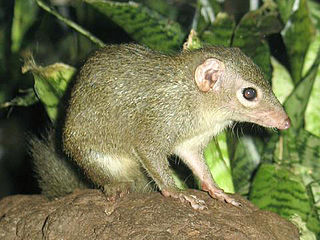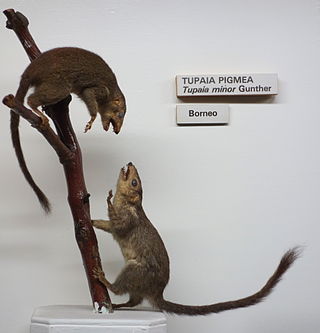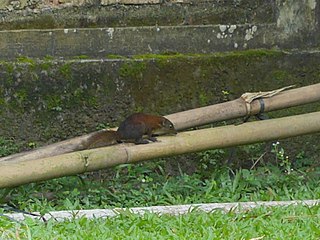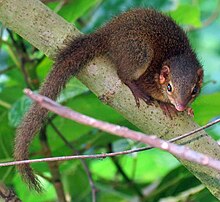
The treeshrews are small mammals native to the tropical forests of South and Southeast Asia. They make up the entire order Scandentia, which split into two families: the Tupaiidae, and the Ptilocercidae.

The Madras treeshrew, also known as the Indian treeshrew, is a species of treeshrew in the monotypic genus Anathana found in the hill forests of central and southern India. The genus name is derived from the Tamil name of moongil anathaan and the species name is after Sir Walter Elliot of the Indian Civil Services in Madras.

The singing bush lark or Horsfield's bush lark is a species of lark which inhabits grassland throughout most of Australia and much of Southeast Asia. It was described by the American naturalist Thomas Horsfield.

The common treeshrew is a small mammal in the treeshrew family Tupaiidae, and is native to Thailand, Malaysia, and Indonesia. It has been listed as Least Concern by IUCN as it remains common and displays some adaptability to ongoing habitat loss.

The golden-bellied treeshrew is a treeshrew species within the Tupaiidae. It is also called Mentawai treeshrew as it is endemic to the Indonesian Mentawai islands of Sipora, North and South Pagai. It lives in forests, and is considered endangered due to habitat loss since the islands' forests are continuously logged.

The pygmy treeshrew is a treeshrew species within the family Tupaiidae. It is native to Thailand, Malaysia and Indonesia. The generic name is derived from the Malay word tupai meaning squirrel or small animals that resemble squirrels.

The mountain treeshrew is a treeshrew species within the Tupaiidae. It is endemic to Borneo and inhabits montane forests in Sarawak and Sabah, Malaysia, and Kalimantan, Indonesia.

The Nicobar treeshrew is a treeshrew species within the Tupaiidae. It is endemic to the Nicobar Islands where it inhabits the islands' rain forests. It is threatened by habitat loss.

The painted treeshrew is a treeshrew species of the family Tupaiidae.

The ruddy treeshrew is a treeshrew species in the family Tupaiidae. It is endemic to Borneo, the Natuna Islands and the Anambas Islands.

The large treeshrew is a treeshrew species within the Tupaiidae. It is native to Sumatra and adjacent small islands, as well as in the lowlands and hills of Borneo.

The Mindanao treeshrew, also called the Philippine tree shrew, is a species of treeshrew endemic to the Mindanao region in the Philippines. It was formerly considered the only member of the genus Urogale, but that genus was merged into Tupaia when the species was found to nest within the latter genus in a molecular phylogeny. The scientific name commemorates British colonial administrator and zoological collector Alfred Hart Everett.

Tupaia is a treeshrew genus in the family Tupaiidae that was first described by Thomas Stamford Raffles in 1821. The name of this genus derives from the Malay word tupai meaning squirrel or small animal resembling a squirrel.

Tupaiidae is one of two families of treeshrews, the other family being Ptilocercidae. The family contains three living genera and 19 living species. The family name derives from tupai, the Malay word for treeshrew and also for squirrel which tupaiids superficially resemble. The former genus Urogale was disbanded in 2011 when the Mindanao treeshrew was moved to Tupaia based on a molecular phylogeny.
The Bangka Island treeshrew, also known as the Bangkan treeshrew, is a treeshrew species within the Tupaiidae. It was previously listed as a junior synonym to Tupaia glis, but was raised up to species status in 2013. It is only found on Bangka Island, which is off the coast of Sumatra. While there is no study yet about its habitat, it may be similar to T. glis's which resides in primary dipterocarp forest. It is likely that it is threatened by local deforestation.

The Sumatran treeshrew is a treeshrew species within the Tupaiidae family. It was previously listed as a subspecies of Tupaia glis for one hundred years, but was raised up to species status in 2013. It is found on the islands of Sumatra and Tanahbala in Indonesia. It is the type species for the Tupaia genus.
The Javan treeshrew or large Javan treeshrew is a treeshrew species within the Tupaiidae family. It was originally described as a subspecies of Tupaia ferruginea and later listed as a junior synonym of Tupaia glis, but was raised up to species status in 2013. It is found on the island of Java in Indonesia.

















